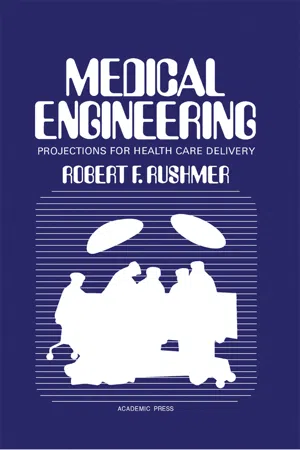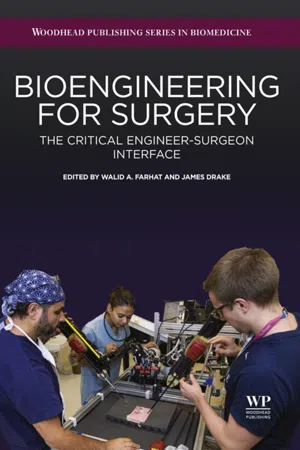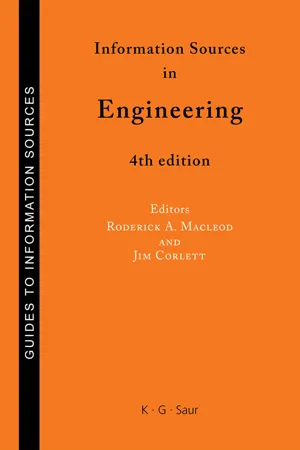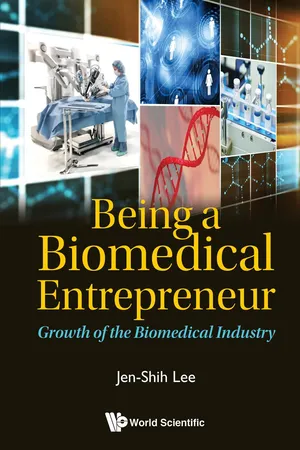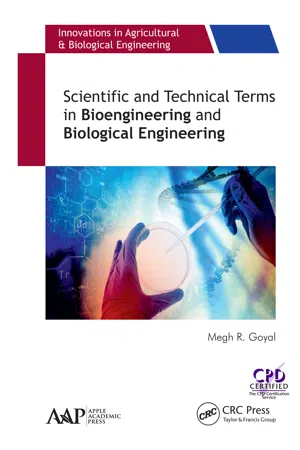Technology & Engineering
Biomedical Engineering
Biomedical engineering involves the application of engineering principles and design concepts to medicine and biology for healthcare purposes. It encompasses the development of medical devices, diagnostic equipment, and advanced therapies, as well as the integration of technology with the human body to improve healthcare outcomes. This interdisciplinary field combines expertise in engineering, biology, and medicine to address complex health challenges.
Written by Perlego with AI-assistance
Related key terms
1 of 5
8 Key excerpts on "Biomedical Engineering"
- eBook - PDF
Medical Engineering
Projections for Health Care Delivery
- Robert Rushmer(Author)
- 2012(Publication Date)
- Academic Press(Publisher)
Although the students all come from the same population pool in high school, they diverge widely when they choose between engineering or biomedical areas on entrance into colleges or universities. The division was formerly so complete that engineering students received no course work in biology and students of biology and medicine were exposed to no contact with engineering. The intellectual barriers between these two vitally important areas are now being breached at a few sites in the academic structure. First, a growing number of students with engineering training are applying as candidates for advanced degrees in basic medical sciences, medicine, and 321 322 9. Technological Training of Medical Manpower dentistry. The numbers are still small but very significant. Most of the formal training of hybrid bioengineers is taking place within engineering colleges in doctoral programs with information input from the basic medical science departments (or clinical departments). Hybrid bioengineering training is designed to prepare its graduates for academic positions to serve independently in teaching and research. In contrast, collaborative teams represent a very wide spectrum of backgrounds, extending all the way from the thoroughly trained bioengineer to the physician with little or no training in engineering, physical sciences or mathematics. Engineers with no formal training in biology or in medicine can also contribute effectively in collaborative relationships. Some engineers increase their competence by postdoctoral training in biological or medical environments. The future of Biomedical Engineering depends in large measure on our ability to build and strengthen the interconnections between the diverse disciplines of engineering, biology, and medicine. - eBook - ePub
Bioengineering for Surgery
The Critical Engineer Surgeon Interface
- Walid Farhat, James Drake(Authors)
- 2015(Publication Date)
- Chandos Publishing(Publisher)
Chapter 1Interface between Engineering and Medicine
Thomas Looi Centre for Image Guided Innovation and Therapeutic Intervention, Hospital for Sick Children, Toronto, ON, CanadaAbstract
Biomedical is a unique field of engineering that combines traditional engineering knowledge with biological/medical applications. With medicine becoming more complex and specialized, engineering helps to create new diagnostic and interventional devices. However, there is a challenge in developing novel applications because the fields of medicine and engineering are quite different, and have their own jargon and culture. To address this gap, this chapter applies the concept of “systems engineering” as a technique to facilitate the synthesis of engineering and medical knowledge. In this chapter, to support the use of systems engineering, concepts such as requirement definitions, functional block diagrams, mechanical systems design, electrical systems design, and control/software systems design are introduced.Keywords
Control systems and software systems; Electrical systems; Functional block diagrams; Mechanical systems; Requirements; Systems engineering1.1. Introduction to Systems Engineering
1.1.1. Medicine and Engineering: Bridging the Divide
Biomedical Engineering is the application of engineering principles to the field of biology and medicine. When compared with other traditional fields of engineering, such as mechanical and electrical engineering, Biomedical Engineering is relatively young and sometimes considered a subspecialization of the broader specialties. However, Biomedical Engineering is unique because it attempts to develop technology for the medical area that has often been seen as distinct and unrelated to engineering. Historically, medicine and engineering were considered to be at the opposite ends of the education spectrum because one deals with the human body and life sciences, whereas the other is involved in the study of math and physical sciences. The education system has also reinforced this ideology because university applicants to either program do not necessarily overlap in their course work and preparation. - eBook - PDF
Biomedical Engineering
Bridging Medicine and Technology
- W. Mark Saltzman(Author)
- 2015(Publication Date)
- Cambridge University Press(Publisher)
To help with this process, I have included pro fi les of other individuals in Biomedical Engineering, including pioneers of the fi eld as well as recent graduates. In each pro fi le I summarize brie fl y the career of the individual and then, where possible, I have asked each person to describe his or her own feelings about Biomedical Engineering, how she or he got started in the fi eld, and how it has impacted her or his life. SUMMARY n Life expectancy and quality of life have increased for people in most nations of the world during the last century; the development of reliable, safe, and inex-pensive medical technology by biomedical engineers has played an important role in this enhancement. Biomedical Engineering: Bridging Medicine and Technology 26 n Emergency rooms, hospitals, doctors ’ of fi ces, and homes contain medical instru-ments and products that resulted from 20th century Biomedical Engineering. n Biomedical Engineering is the application of science, mathematics, and engin-eering design principles to improve human health. n Human physiology is the foundational science that distinguishes Biomedical Engineering from other forms of engineering; throughout history, advances in our understanding of physiology have led to new Biomedical Engineering technology. BOX 1.2 Solving engineering problems Good engineers are skilled at making estimates and solving problems. The problems in Chapter 1 were designed to exercise your skill at estimation. As you solve these problems, and those throughout the book, develop a systematic approach for thinking about and presenting your work on each problem. Here are some guidelines to help in developing and presenting your solutions to engineering problems. General features • Use fi ne-lined paper, preferably lined in grids (like graph paper) to facilitate drawing of diagrams and graphs. - eBook - PDF
- Roderick A. Macleod, Jim Corlett, Roderick A. Macleod, Jim Corlett(Authors)
- 2012(Publication Date)
- De Gruyter Saur(Publisher)
Journals and Conference proceedings Bioengineering/ Biomedical Engineering Peter Richards INFORMATION SOURCES IN ENGINEERING 31 ! • are not listed as it is considered that their existence can be accessed through those Library and Society websites given here and elsewhere in this volume. For students making the transfer from the Physical Sciences to the Life Sciences, one major difference they notice is that whilst the former tend to be mathematical in their descriptions, the latter are 'full of words.' However, the conventions and words used in Anatomy have evolved over several hun-dred years, and their use can be as precise as any mathematical formulae. It is a sad fact that those who named the subjects that unite engi-neering and the life sciences were not rigorous in their choice of language; this has led to confusion. The result of these past demeanours is that almost every worker has his or her own definition of the subject area of this chapter, and many of the societies, institutions and educational establish-ments involved in the field spend what seems to be an inordinate proportion of their various mission statements describing the limitations they would put on the their own definition of the subject. As will be seen later, this work is no exception in presenting its own definitions; it does not, however, claim their superiority, they are included to enable progress. • DEFINITIONS 1. General Biomedical Engineering is defined, as 'the application of engineering prin-ciples to the study treatment and enhancement of human health and performance'. Even with such a simple and seemingly straightforward definition it can be seen that it is a huge field for information retrieval, spanning all of engineering, all of medicine, many of the major life sciences and areas of sports science, computing and even some social sciences. - eBook - ePub
Being a Biomedical Entrepreneur
Growth of the Biomedical Industry
- Jen-Shih Lee(Author)
- 2018(Publication Date)
- WSPC(Publisher)
Chapter 2 Education of Biomedical Engineers 2.1. Advancements in Biomedical Engineering The past 50 years have seen an explosion of activities in the healthcare field. Medical researchers and entrepreneurs have identified and developed a range of new products and processes that are intended to address an ever expanding range of medical conditions. This growth has been led by the medical device and biotechnology industry and, more recently, the expansion of the molecular diagnostics industry and digital health industry. Although the medical device and biotechnology industry has experienced a number of boom or bust periods during that time, the overall growth in the number of medical products and product revenues has been dramatic. We anticipate that the coming years will continue to see tremendous growth in the field of Biomedical Engineering. In particular, those individuals, who are able to marry their clinical and engineering capabilities with an entrepreneurial mindset, have the potential to become this century’s Bill Gates or William Hewlett. During the first three years of the 21 st century, important and exciting developments have taken place in education and research in biomedical imaging and bioengineering, including the following: • The National Institute of Health (NIH) provides Small Business Innovation Research (SBIR) and Small Business Technology Transfer (SBTT) grants to support research and development by small businesses in the United States. 1,330 such grants that totaled $623 million were made in 2015. • The National Institute of Biomedical Imaging and Bioengineering (NIBIB was established by the NIH, with a 2003 budget of $121 million. By 2015, NIBIB’s budget had grown to $328 million. More than 80% of this funded research and training at universities, hospitals, industries and research institutions throughout the country - eBook - ePub
Biomedical Engineering
Materials, Technology, and Applications
- Hossein Hosseinkhani(Author)
- 2022(Publication Date)
- Wiley-VCH(Publisher)
1 Concepts of Biomedical Engineering1.1 Introduction
Biomaterials technology is one newly emerging biomedical form to create new device and induce the regeneration of detective and injured body tissues and organs as well as to substitute the biological functions of damaged organs. To this end, the cells of high proliferation and differentiation potentials are being combined with some cell scaffolds and biological signals of growth factor and gene. Since there are some cases in which cells are genetically innovated to produce the growth factors inducible angiogenesis and tissue regeneration, the technology of gene delivery is also necessary for tissue engineering. Current developments in the technological fields of biomedical and tissue engineering, bioengineering, biomechanics, microfabrication, and microfluidics have led to highly complex and pertinent new tools for in vitro and in vivo applications. The purpose of biomaterials technology is to mimic organ tissues in vitro in order to partially reduce the amount of in vivo testing. These types of systems can enhance functionality of cells by mimicking the tissue architecture complexities when compared to in vitro analysis and at the same time present a more rapid and simple process when compared to in vivo testing procedures. The development of new technology for analysis of engineered tissues can be achieved through the combination of these research domains. Combining these advanced research domains, we then present a new area of technology that allows analysis in vitro - Megh R. Goyal(Author)
- 2018(Publication Date)
- Apple Academic Press(Publisher)
Medical/biomedical imaging is a major segment of medical devices. This area deals with enabling clinicians to directly or indirectly view things that are not visible through normal sight (due to their size, and/or location). This can involve utilizing ultrasound, magnetism, UV, other radiology, and other means. Imaging technologies include: fluoroscopy, magnetic resonance imaging (MRI), nuclear medicine, positron emission tomography (PET), X-rays and CT scans, tomography, ultrasound, optical microscopy, and electron microscopy.Implants: An implant is a kind of medical device designed to replace and act as a missing biological structure (as compared with a transplant, which indicates transplanted biomedical tissue).The best contribution of bionics is in the field of BME. BME is the building of useful replacements for various parts of the human body. Biomedical engineers work hand-in-hand with doctors to build the artificial body parts.Clinical engineering is the branch of BME dealing with the actual implementation of medical equipment and technologies in hospitals or other clinical settings. Major roles of clinical engineers include training and supervising biomedical equipment technicians (BMETs), selecting technological products/services and logistically managing their implementation, working with governmental regulators on inspections/audits, and serving as technological consultants for other hospital staff. Clinical engineers also advise and collaborate with medical device producers regarding prospective design improvements based on clinical experiences, as well as monitor the progression of the state-of-the-art, so as to redirect procurement patterns accordingly. Clinical engineering departments will sometimes hire not just biomedical engineers, but also industrial/systems engineers to help and address operations research/optimization, human factors, cost analysis, etc. The safety engineering includes procedures used to design safe systems in BME.- Dhanjoo N. Ghista(Author)
- 2012(Publication Date)
- IntechOpen(Publisher)
In case of a biomedical engineer, however, the relations are far more complex than the schemes sketched by corporate culture promoters for a typical customer service (Denison & Mishra, 1995). The above-mentioned elements of the BME-related corporate culture cannot be formed only as spontaneous forms of behavior of clinical engineers. They must be prepared by special methods and techniques of teaching and learning to help young students become highly qualified and well-prepared specialists also in the ethical dimension of their work. This process of ethical formation must be closely combined with professional skill formation, because ethics is not simply an additional competence of the future biomedical engineer, but rather a crucial element determining the use of basic knowledge in all practical applications. Therefore teachers who teach Biomedical Engineering students must take this additional demand into account (Augustyniak E. & Augustyniak P. 2010). 3.1 Mutual understanding and good cooperation within a multidisciplinary team Biomedical Engineering integrates various technical disciplines, but it also assumes the presence of an engineer in every situation where medicine is being practiced. Therefore, one of the principal requirements is the ability to work in a multidisciplinary team, in which common ideas, values and behavioral patterns have a very practical implication influencing the emergency response, adaptation to conditions of any healthcare mission and a sense of intellectual curiosity about technological development. In such teams, various professional learning-related particular interests are present, and mutual understanding instead of competition is the key to success. The organizational culture of the School created by all workers from various departments of the School fosters an emphasis on teamwork and intercommunication, especially in the group of specialists from various fields.
Index pages curate the most relevant extracts from our library of academic textbooks. They’ve been created using an in-house natural language model (NLM), each adding context and meaning to key research topics.
